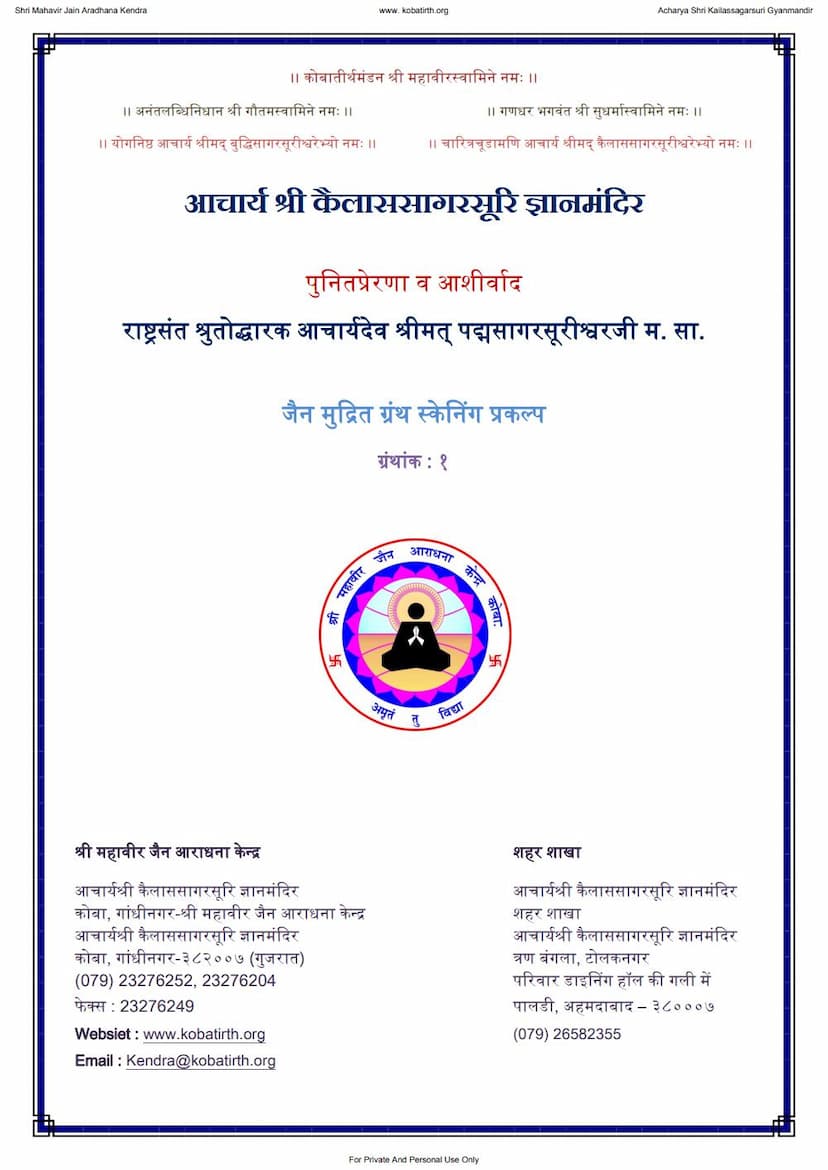Agam 26 Prakirnaka 03 Maha Pratyakhyan Shwetambar
Added to library: September 1, 2025

Summary
This document is a digital scan of the Jain text titled "Agam 26 Prakirnaka 03 Maha Pratyakhyan Shwetambar," authored by Purnachandrasagar and published by Jainanand Pustakalay. The scan is provided by the Shri Mahavir Jain Aradhana Kendra in Koba, Gujarat, for private and personal use.
The document begins with salutations and acknowledgments to various Jain Acharyas and institutions. It then dedicates itself to the revival and preservation of Jain Agamas (scriptures).
A significant portion of the document is dedicated to the history of the Jain Agamas and the efforts made to preserve them through various "recitations" or compilations (Vachanas). It details:
- The origin of the Agamas: Attributed to the eleven Gandharas of Lord Mahavir Swami, starting with Shri Indrabhuti (Gautam Swami).
- The importance of Shrutagnana (scriptural knowledge): Described as a guiding light from the darkness of delusion.
- The six major recitations (Vachanas) of the Agamas:
- First Vachana (Shri Dvadashangashrutasankalan): Held around Veer Nirvana Samvat (VNS) 160 in Pataliputra (Patna) under the presidency of Shri Sthulabhadra Swami due to a severe famine and scattering of monks after Lord Mahavir's demise.
- Second Vachana (Agam Sanrakshan Vachana): Conducted in Ujjain between VNS 245 and 281 under Arya Suhasti Suri, with the patronage of Emperor Samprati, to safeguard the Agamas.
- Third Vachana: Held between VNS 300 and 330, involving a large assembly of monks and lay followers, where the eleven Angas and ten Purvas were organized. This was partly in response to the persecution under Pushyamitra.
- Fourth Vachana: Took place around VNS 592 in Dashpur (Mandsaur) by Arya Rakshit Suri, who organized the Agamas into four Anuyogas (branches of study) to ensure their longevity, especially in anticipation of a severe famine predicted by Vajraswami.
- Fifth Vachana: Conducted around VNS 830-840 in Mathura and Valabhi, with different groups of monks compiling the Agamas in different locations due to the prevailing chaos.
- Sixth Vachana (Valabhi Vachana): The final and most significant compilation, held in Valabhi by Arya Devaddhigani Kshamashraman and Arya Kalak Suri, along with 500 other Acharyas. This is where the 84 Agamas were systematically organized and inscribed on palm leaves, marking the point where the Agamas were put into written form. This Vachana is considered to have occurred around the time when the tradition of ancient knowledge (Purva-gyana) began to decline (VNS 1000).
The text then discusses the decline in the systematic study and preservation of Agamas after the sixth Vachana, highlighting the impact of difficult times and the rise of laxity in practice from the 10th century onwards. It mentions that access to Agamas became difficult, and the oral tradition was significantly weakened by the 20th century.
The document then pays tribute to Acharya Shri Anand Sagar Surishwarji Maharaj, who is lauded as an "Agamoddharak" (reviver of Agamas). It describes his immense contribution in re-printing and re-popularizing the Agamas. Despite having a short period of tutelage under his guru, Muni Shri Jhaver Sagarji, he gained profound knowledge and took on the responsibility of preserving the Agamic heritage. He organized community recitations of the Agamas in various locations between V.S. 1971 and 1977, reading 26 texts totaling approximately 2,33,200 verses. He also guided other scholars like Muni Shri Punyavijayji in this endeavor.
The present work, "Shri Mahapachchakkhan Sutra," is presented as a part of this revival effort, edited and compiled by Purnachandrasagarji M.S., a disciple of Acharya Shri Hemchandsagar Suri. The document lists the institutions and individuals who contributed to the publication, including the Jainanand Pustakalay, Surat.
The latter part of the document contains the actual text of the "Shri Mahapachchakkhan Sutra" in Prakrit, with Gujarati transliteration and commentary (implied by the context and the names mentioned). This section focuses on:
- Renunciation (Pratyakhyan): The core theme of the text is about taking vows of renunciation and abstaining from sins. It details various forms of renunciation, including:
- Renouncing worldly attachments, body, and possessions.
- Renouncing negative emotions like anger, pride, deceit, greed, hatred, and attachment.
- Renouncing sins and wrongdoings.
- Taking vows related to ethical conduct, such as non-violence, truthfulness, non-stealing, celibacy/chastity, and non-possession.
- Self-Reflection and Repentance: The text emphasizes the importance of confessing sins (Pratikraman), condemning them, and seeking forgiveness. It highlights the role of the Guru in guiding the process of repentance and purification.
- The Nature of the Soul: It talks about the soul's inherent nature as consciousness and knowledge, distinct from external possessions and karmic bonds.
- The Cycle of Birth and Death: It describes the suffering caused by attachments and the cycle of rebirth, emphasizing the need to break free from these cycles.
- The Path to Liberation (Nirvana): The text implicitly points towards the path of righteous conduct, knowledge, and faith as the means to achieve liberation.
- Austerities and Practices: It mentions the importance of austerities (tapas) and meditation (dhyana) in purifying the soul and overcoming karmic obstacles.
- The Significance of Monkhood: The text suggests that adopting a renunciate life (sadhana) and following the teachings of the Tirthankaras is crucial for achieving spiritual progress.
- The Five Great Vows (Mahavratas): The text elaborates on observing the five Mahavratas with utmost care and discipline.
- The Importance of Right Faith, Knowledge, and Conduct: These are presented as the four pillars of spiritual progress.
In essence, "Maha Pratyakhyan" is a profound Jain scripture that guides individuals on the path of spiritual purification through rigorous self-discipline, renunciation of worldly desires and negative emotions, and adherence to Jain ethical principles, ultimately leading towards liberation. The publication of this text is presented as a continuation of the vital work of preserving and disseminating the ancient Jain wisdom.